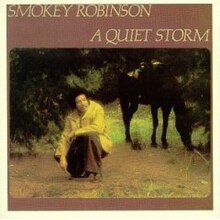A Quiet Storm
| A Quiet Storm | ||||
|---|---|---|---|---|
 | ||||
| Studio album by | ||||
| Released | March 26, 1975[1] | |||
| Recorded | 1974–1975 | |||
| Genre | ||||
| Length | 36:01 | |||
| Label | Tamla | |||
| Producer | Smokey Robinson | |||
| Smokey Robinson chronology | ||||
| ||||
A Quiet Storm is the 1975 third solo album by American soul singer, songwriter, and producer Smokey Robinson. The album received generally positive reviews, and spawned the hit single "Baby That's Backatcha", which spent one week at the top of the Billboard Hot Soul Singles chart.[2]
According to Pitchfork journalist Eric Harvey, A Quiet Storm revitalized Robinson's career after having left his group the Miracles, and typified what would become known as the quiet storm radio format.[3]
Critical reception
| Review scores | |
|---|---|
| Source | Rating |
| AllMusic | |
| Christgau's Record Guide | B[4] |
| MusicHound R&B | 4/5[5] |
| The Rolling Stone Album Guide | |
A Quiet Storm is one of the most highly-acclaimed soul albums of the 1970s. This album spawned three hit singles, including Robinson's first disco hit "Baby That's Backatcha", rising to number 7 on the Billboard Disco chart (Top 10 R&B). The album re-established Robinson's reputation as a master songwriter and producer and solidified his solo success after leaving his influential Hall of Fame group, the Miracles.
In a contemporary review for Rolling Stone, Robert Palmer said A Quiet Storm proved Robinson was "still a dynamic creative force" as it succeeded on the strength of his singing and production, although he highlighted the "sexy directness" of the title track and "Baby That's Backatcha".[7] Vince Aletti ranked it as the year's third best album in his ballot for the 1975 Pazz & Jop critics poll.[8] Robert Christgau was less enthusiastic, believing the title track was somewhat bold for concentrating Pure Smokey's "drift into a style", but finding much of the record lacking rhythm, with the exception of "Love Letters" and "Coincidentally".[4]
A Quiet Storm was later named one of the greatest Motown albums of all time in a 1999 edition of Q.[9] According to Pitchfork journalist Eric Harvey, the record reinvented Robinson's brand of "contemplative romantic soul" with the Miracles, revitalized his career after two underperforming solo albums, and typified what would become known as the quiet storm radio format.[3]
Miracles member Marv Tarplin was also a contributor to this album.
Track listing
All tracks composed and arranged by Smokey Robinson; except where indicated.
- "Quiet Storm" (Robinson, Rose Ella Jones) 7:47
- "The Agony and the Ecstasy" 4:46
- "Baby That's Backatcha" 3:36
- "Wedding Song" 3:20
- "Happy" – Love Theme from Lady Sings the Blues (Robinson, Michel Legrand) 7:05
- "Love Letters" 4:04
- "Coincidentally" 4:22
- The "Wedding Song" was originally composed for the wedding of Jermaine and Hazel Joy Jackson December 15, 1973.[10]
Personnel
- Smokey Robinson – lead vocals
- Melba Bradford – backing vocals
- Joseph A. Brown, Jr. – drums, percussion
- Carmen Bryant – backing vocals
- Gary Coleman – percussion
- Shawn Furlong, Terry Furlong – sound effects, sopranino
- Michael Jacobsen – electric cello
- Gene Pello – drums
- James "Alibe" Sledge – bongos, congas, backing vocals
- Fred Smith – horns, woodwind
- Russ Turner – musical arrangements, keyboards, backing vocals
- Marv Tarplin – guitar
- Technical
- Greg Venable, Russ Terrana - mixing engineer
- Katarina Pettersson - art direction
- Jim Britt - photography
Charts
Weekly charts
| Year | Album | Chart positions[11] | |
|---|---|---|---|
| US | US R&B | ||
| 1975 | A Quiet Storm | 36 | 7 |
Year-end charts
| Chart (1975) | Peak
positions |
|---|---|
| U.S. Billboard Pop Albums[12] | 77 |
Singles
| Year | Single | Chart positions[13] | ||
|---|---|---|---|---|
| US | US R&B |
US Dance | ||
| 1975 | "Baby That's Backatcha" | 26 | 1 | 7 |
| "The Agony and the Ecstasy" | 36 | 7 | — | |
| 1976 | "Quiet Storm" | 61 | 25 | — |
References
- ^ a b https://www.allmusic.com/album/r16689/review
- ^ "Hot R&B/Hip-Hop Songs (1975-05-24)". Billboard. Archived from the original on August 16, 2022. Retrieved August 15, 2022.
- ^ a b Harvey, Eric (May 15, 2012). "The Quiet Storm". Pitchfork. Archived from the original on August 16, 2022. Retrieved February 10, 2017.
- ^ a b Christgau, Robert (1981). "Consumer Guide '70s: R". Christgau's Record Guide: Rock Albums of the Seventies. Ticknor & Fields. ISBN 089919026X. Retrieved March 12, 2019 – via robertchristgau.com.
- ^ Graff, Gary; du Lac, Josh Freedom; McFarlin, Jim, eds. (1998). "Smokey Robinson". MusicHound R&B: The Essential Album Guide. Visible Ink Press. ISBN 1578590264.
- ^ Brackett, Nathan; Hoard, Christian, eds. (2004). "Smokey Robinson". The Rolling Stone Album Guide (4th ed.). Simon & Schuster. p. 693. ISBN 0-7432-0169-8.
- ^ Palmer, Robert (July 31, 1975). "A Quiet Storm". Rolling Stone. Retrieved February 10, 2017.
- ^ Christgau, Robert (December 29, 1975). "It's Been a Soft Year for Hard Rock". The Village Voice. Retrieved February 10, 2017.
- ^ Anon. (October 1999). "Best Motown Records of All Time". Q. p. 161.
- ^ The Jacksons, Fred Bronson (2017-10-24). The Jacksons: Legacy. ISBN 9780316473743. Retrieved 2019-12-08.
- ^ "Smokey Robinson US albums chart history". allmusic.com. Retrieved 2011-06-30.
- ^ "Billboard 200 Albums - Year-End". Billboard. Retrieved 2021-09-10.
- ^ "Smokey Robinson US singles chart history". allmusic.com. Retrieved 2011-06-30.
